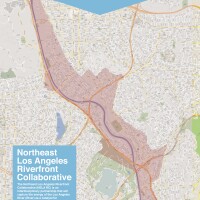Goal 3: Connect Neighborhoods and River via Enhanced Mobility

The complex network of public infrastructure, including the River and the freeway system, has limited the overall mobility between communities. By increasing the range of mobility options within NELA, the functions of daily life are made easier. The connections between neighborhoods and to the River not only promote a healthy lifestyle, but also increase access to the assets within and surrounding the NELA area.NELA's public infrastructure, such as its community centers, streets, and transit systems, help support the functions of daily life while connecting neighborhoods to one another and to the River. These connections help the River become the "green spine" of the City, promoting healthy lifestyle choices while increasing mobility access for all residents.
Since the 1980's, several projects of varying size have been built near the River. These projects include public improvements, such as greenways and parks, and private development, especially residential and commercial uses. Unlike previously built projects, these projects embraced the River as a component of their existence. However, there remains a disconnect between the neighborhoods and the River.

Within NELA, there are a range of nodes that provide a distinct neighborhood identity. Pinpointing such nodes can facilitate the connectivity between the River and each neighborhood by pulling in people and resources within a close distance.
- Neighborhood Centers are areas with higher concentration of neighborhood serving uses, which are adjacent and easily accessible to residential communities. These existing centers are local destinations with the potential for creating a regional draw. Existing neighborhood centers include Los Feliz and Glendale Boulevards in Atwater Village, as well as Cypress Avenue and Figueroa Street in Cypress Park.
- Community Resource Centers are places where recreational or social resources are concentrated, such as parks, schools, restaurants, and bars. NELA is characterized by a constellation of resources dispersed unevenly through neighborhoods.
Employment Centers are areas with concentrated employment opportunities. Within NELA, 35% of the site is zoned for commercial and industrial uses, primarily located in north Atwater Village, the Taylor Yards area in Cypress Park, and the portion of Lincoln Heights located in the Cornfield Arroyo Specific Plan area.
These nodes remain isolated due to inefficient or lack of mobility connections. The following objectives seek to improve multi-modal transportation within the Study Area while supporting the distinct and varying nodes that define NELA's community.
Objectives

A. Improve street and sidewalk infrastructure
Much of NELA's neighborhood centers and resources can be easily accessible by foot or bicycle. Some community resources are isolated destinations serving single purposes. To maximize connections between the various nodes within NELA and extend these connections to the River, it is important to provide for a pedestrian and bicycle friendly public realm. Potential improvements include dedicated bike lanes, wider sidewalks, and other traffic calming improvements, such as landscaping, street furniture, and signage.
Encouraging non-motorized commutes has numerous benefits. In addition to promoting healthier lifestyles that directly correlate with reduced rates of diabetes and obesity, the public spaces in the communities are more vibrant with people and streets may have fewer cars due to reduced daily vehicle trips
B. Enhance transit systems serving neighborhoods
Currently, the Study Area lacks coordination between varying transit opportunities, making transit trips unnecessarily long and arduous for an everyday user. Buses and local DASH routes have the greatest potential to meet the public transit needs of stakeholders. Buses allow for greatest flexibility, especially as connectors to transit hubs, such as the two Gold Line stations or the Glendale Metrolink station.
Creating a robust transportation network designed to improve overall accessibility and mobility will require increased frequency of select bus services, transit plazas at key intersections, and local DASH service. Along with more walkable and bikeable streets, the seamless transition between the various modes of transportation will better serve community members.
C. Create a NELA specific parking strategy
While non-vehicular transportation is the key to enhancing mobility within the Study Area, there also needs to be guidance for improving the movement and parking of vehicles. These efforts should be aligned with the use of multi- modal and non-vehicular transportation. Together, community businesses can grow, especially recreational river opportunities, but not at the expense of residential communities.
With the growing popularity of River-related activities, often leading to vehicular inundation in residential communities, a holistic approach to parking is essential. Any strategy must feature the coordination of parking lots within a community, strategically placed near transit opportunities and popular nodes. Many neighborhoods, especially Elysian Valley, have built- out industrial and commercial communities with non-confirming parking rights. In order to encourage much needed retail and commercial services, a coordinated and shared parking system needs to be created.


